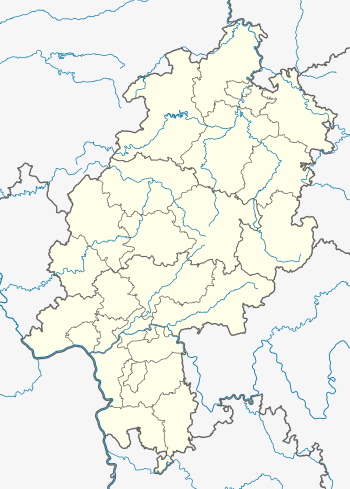Bierstadt
Bierstadt is a borough of the city of Wiesbaden, capital of the state of Hesse, Germany. The district is located in the eastern part of the city, directly east of downtown Wiesbaden, and has about 12,300 inhabitants. Formerly an independent municipality, the town was incorporated into Wiesbaden on April 1, 1928. While Bierstadt can be translated Beer Town, the name is actually derived from Saint Brigid of Kildare, Ireland (Birgid in German).
Bierstadt | |
|---|---|
Borough of Wiesbaden | |
 Coat of arms | |
Location of Bierstadt in Wiesbaden | |
 Bierstadt  Bierstadt | |
| Coordinates: 50°05′00″N 8°17′00″E | |
| Country | Germany |
| State | Hesse |
| District | Urban district |
| City | Wiesbaden |
| Government | |
| • Mayor of Borough | Reinhold Hepp (CDU) |
| Area | |
| • Total | 9.22 km2 (3.56 sq mi) |
| Population (30.06.2008) | |
| • Total | 12,304 |
| • Density | 1,300/km2 (3,500/sq mi) |
| Time zone | CET/CEST (UTC+1/+2) |
| Postal codes | 65191 |
| Dialling codes | 0611 |
History

The earliest traces of settlement in the Bierstadt area date to the Stone Age. However, Bierstadt was first mentioned in historical records, as "Birgidestad", in a deed of gift on March 12, 927. The town was founded by Irish monks, who named it after the Irish national saint, St. Brigid. In the 11th–12th centuries, the (now Protestant) Church of St. Nicholas was built. The church is not only the oldest existing church in Wiesbaden, but, after the Roman-era Heathens' Wall in downtown Wiesbaden, is the second oldest building of any kind in the city.
In the Middle Ages, Bierstadt came under the dominion of Nassau, but was subject to strong influences from the Archdiocese of Mainz. In the wake of the Reformation, Bierstadt came fully under the control of Nassau.
After the Thirty Years' War, the town had only 17 inhabitants. Efforts at reconstruction were set back through a fire in 1691. By the middle of the 18th century, Bierstadt had about 500 residents.
The remains of a medieval watchtower, the Bierstadter Warte, are located on a height between Wiesbaden and the district. The Warte is now part of the coat of arms. In 1898, a large observation tower, the Wiesbaden Bismarck Tower, was planned to be built at this site. A temporary wooden tower was constructed in 1910, but funding for the permanent structure could not be obtained. The temporary tower was demolished in 1918.
During the Third Reich, Nazism dominated in Bierstadt. On November 9, 1938, the Bierstadt synagogue, dating to 1827, was destroyed.
After World War II, about 1800 homes were built in Bierstadt for occupation forces of the United States Army. The Aukamm and Crestview developments are located on the northwest and west side of Bierstadt, respectively.
Infrastructure
Bierstadt has a library and two schools, including one primary school - Grundschule Bierstadt, and a gymnasium named Theodor-Fliedner-Schule which was formerly a middle school. Bierstadt is next to the Aukammtal and has access to the German Federal Route 455.
Bierstadt has two churches. In addition to the Protestant church (formerly the church of St. Nicholas), there is the Roman Catholic church of St. Birgid.
Twinning
Since 1991, Bierstadt has had a partnership with the French commune of Terrasson-Lavilledieu. The town of Terrasson is located on the banks of the Vézère in southwestern France, about 150 km east of Bordeaux in the heart of Aquitaine, with which Hesse maintains a regional partnership.
Sources
- adapted from German Wikipedia
External links
- Post GR07 at American Legion Centennial Celebration (centennial.legion.org)
- https://web.archive.org/web/20041226015846/http://www.wiesbaden.de/leben_wi/stadtteile/bierstadt.php (in German)
- http://www.marlionetta.de
- https://web.archive.org/web/20030801182401/http://www.fc34bierstadt.de/
- http://www.kornmayer.com
